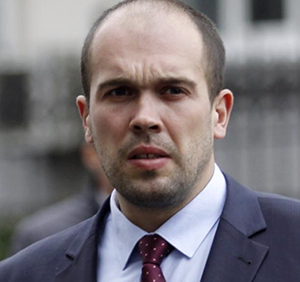 DEBATE. In Ukraine, there is an anti-terrorist operation going on more than one year. It may be considered the longest one of this kind in the history of fighting terrorism. Armed hostilities, loss of thousands human lives, conversion of the Donetsk and Lugansk regions into the area of humanitarian and environmental disaster. What is this if not a war?
DEBATE. In Ukraine, there is an anti-terrorist operation going on more than one year. It may be considered the longest one of this kind in the history of fighting terrorism. Armed hostilities, loss of thousands human lives, conversion of the Donetsk and Lugansk regions into the area of humanitarian and environmental disaster. What is this if not a war?
By Alexandr Tolokonnikov, journalist, founder of ”The Ukrainian Foundation for Community Development” (NGO), Head of ”Youth and Family Committee of the Public Council of Dnipropetrovsk region”.
Destabilization of the political situation in the eastern Ukraine dates back to the Russia’s annexation of the Crimea. Because of the support of the pro-Russian population by the Russian secret services the mass provocations took place. The Russian flags were hung up on the governmental buildings, the Ukrainian revolutionists were attacked, and national symbols were demonstratively destroyed.
In April 2014 separatists proclaimed the creation of the so-called Donetsk and Lugansk republics. On the 6th of April diversionary units of the Russian Federation supported by the local separatists occupied the Donetsk region administrative buildings. As a result of a practically total absence of military divisions on the territory of Donbass Kiev was not able to promptly react to the situation in the zone of an arising conflict. Already in April the control over the majority of the Donetsk and Lugansk regions was practically lost.
After the illegal referendums under the “Crimean scenario” the self-proclaimed “DNR” and “LNR” appeared. Exactly at that time the Verkhovna Rada of Ukraine headed by the deputy President of Ukraine Olexandr Turchinov, made a decision to start the anti-terrorist operation. It had soon acquired the characteristics of the full-scale war, however, its official name was never changed. Armed hostilities involving the usage of multiple launch rocket systems, armored vehicles, heavy artillery and even aviation were continued to be called the “antiterrorist operation”.
The characteristic feature of the conflict is the participation of a big number of voluntary troops on both sides. It was the voluntary divisions that were one of the most effective forces fought on the Ukrainian side at the initial stage of military actions. Ukraine appeared not to be ready for war. Corruption in the highest ranks of the army, lack of finance, and, as a result, total plunder of material and technical resources led to the catastrophic decrease of defense potential of Ukraine. The first months of the war the army was supported by the volunteers. Due to the combined efforts of all Ukrainian people the funds for the renovation of the army were raised.
Except for the “rebels”, it was the volunteers from Russia who predominantly fought on the separatists’ side. Russia supplied not only combatants but also weapons and military equipment. Each time when the “humanitarian aid” cargo was delivered hostilities usually aggravated. At the initial stage the Ukrainian troops deliberated a number of Donbass’s localities from the pro-Russian separatists.
Nevertheless, after the direct intervention of the Russian troops and failures of the Ukrainian military commanders many Ukrainian soldiers were killed and taken hostages in the “encirclement trap” near Ilovaisk. As a result of these events the strategic offensive initiative was taken by the Russian troops and separatists forces. Afterwards, the courageous defense of the Donetsk airport by the Ukrainian “cyborgs” took place; the Ukrainian side breached the tactical encirclement near Debaltsevo and gained a number of tactical achievements.
As of today, about 12-15 thousands of Russian military servicemen are present on the territory of Donbass. Together with the separatists’ divisions and 50 thousands of Russian military forces at the Russian-Ukrainian border they present a threat of restarting the offensive and occupying new Ukrainian territories. Irrespective of a number of international peace negotiations, the conflict itself obtained a “smouldering” character threatening to cause new armed hostilities.
At the beginning of the conflict the measures on the restoration of the territorial integrity may be politically justified to be named “terrorism fight”, since people in the whole world feel the terrorist threat for a long period of time. Therefore, public opinion in these countries is not in favour of terrorists. Already for one year Ukraine finds itself in the situation of the so-called “hybrid war” with the Russian Federation and pro-Russian separatists.
The “hybrid” character of this war lies not only in combination of the wide-scale military actions and usage of information and economic means of control but also in the fact that Ukraine maintains economic and diplomatic relations with Russia, while reporting on the Russia’s aggression and calling for imposing sanctions against the aggressor.
When will peace be achieved in Ukraine?
To answer this question we must consider direct and indirect participants of the conflict. Pro-Kremlin separatists are controlled and dependent on the financial and military aid from Russia. During negotiations they always coordinate their actions with Moscow. However, there are groups among the separatists which pursue an independent policy controlling separate localities of Donbass.
These groups are either being liquidated or are undergoing “preventive measures” by the Russian special services experts. It is clear that without the support of Russia the self-proclaimed republics would cease to exist not only for the military but also social and economic reasons. The occupied Donetsk and Lugansk regions are Russia’s means of control over Ukraine. No one was going and is going to incorporate these territories into the Russian Federation because this subsidized region is in fact economically destroyed.
After annexing of the Crimea Russia got another subsidized region which, however, unlike the eastern regions of Ukraine, didn’t require reconstruction after the armed hostilities. In such situation more rational for Kremlin would be formal “hand back” of the self-proclaimed republics territories on the conditions of federalization and keeping the factual control over them. From the future perspective this means causing multibillion expenses from the Ukrainian budget aimed to liquidate the post-effects of the conflicts, as well as blocking attempts of Ukraine to join EU or NATO. Today the position of the West is more unanimous than in the beginning of the conflict.
During the year fairly efficient sanctions were introduced, which considerably increased the outflow of the western capital funds from the Russian economy. However, the sanctions are disadvantageous for a number of the EU states. The purpose of the West is not collapse of Russia, since this may lead to appearance of gigantic zone of military and political instability and growth of China’s influence but prevention of Vladimir Putin from realization of his geopolitical ambitions aimed to create the Eurasian empire in which Ukraine was supposed to play a significant role. Under these conditions the Ukrainian party would receive the support of the western states for maintaining its own sovereignty.
Ukraine is trying to restore its territorial integrity but the current condition of Ukrainian economy, expenses on the infrastructure reconstruction and social expenses on the territories controlled by the separatists nowadays may lead to aggravation of the economic crisis, increase of the public debt and the default scenario imminence.
Bringing UN peacekeeping forces to the zone of the conflict may support the Ukrainian territory and prevent the wide-scale attacks of the pro-Russian separatists and Russian forces. This also means the existence of a “frozen conflict” which will give Kiev time to implement economic reforms and to solve social and economic problems, as well as to increase the military efficiency of the national defense forces. Nevertheless, it’s all only theoretical.
The Russian Federation is the permanent member of the United Nations Security Council with the right of veto, which it will surely use.
Unfortunately, Ukraine also has internal problems. It’s more than one year since the criminal regime of Yanukovych has been overturned. However, not only common people didn’t feel changes for better but also the decisive means for fighting corruption were not introduced. Like in the past, some corruption scandals are arising and the confrontation of oligarchs is going on at the political stage.
Several criminal proceedings were initiated. However, not a single corrupt official of the “all state scale” either from the Yanukovich time or from nowadays was brought to justice. All this doesn’t facilitate strengthening economy and political stability.
Moreover, in future it will be necessary to reconstruct Donetsk and Lugansk regions, since Russia will not make it on its own account. Most likely, the sovereignty of Ukraine on the territories controlled today by the terrorists will be restored. However, the question remains concerning the terms and conditions of such reconstruction.
Russian aggression may stop only when the losses will significantly exceed its achievements. This may be possible only on the condition of consolidation of the Ukrainian society, efficient fight of corruption, implementation of economic reforms and, as a result, the increase of the military efficiency of the armed forces of Ukraine. Approximation of the live standards to the European level and economic development will bring Donbass closer to Ukraine sooner that any war.

 NewsVoice är en nättidning för oberoende nyheter, debatt och analys.
NewsVoice är en nättidning för oberoende nyheter, debatt och analys. 
